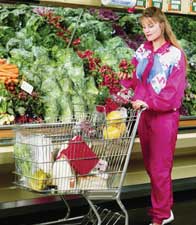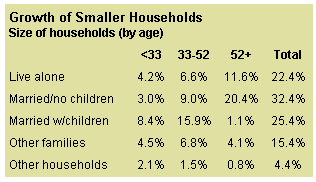
Women are a non-homogenous demographic, and it is challenging to discern what sub-categories offer the most promise and potential. Success depends on selecting opportunities that a company can best exploit, knowing where to focus and understanding where to direct future ideation and new product strategies.
Companies may learn to leverage the drivers of change and, by doing so, can locate areas of marketing opportunities for success in selling to women. The key is understanding how the drivers of change—whether a change in demographics, lifestyle, households or attitudes—are stressful to women and developing products that reduce or eliminate this stress.
One of the most significant demographic changes in the last century is the number of women in the work force. In 1900, 18% of women were employed; by 2000, that number increased to 47%. The number of mothers in the workforce also is significant, and adding even more stress is the fact that a significant and growing number of working moms are single.

New products that provide solutions to stressful problems have a good chance of success. Possibilities include snacks, on-the-go portability, handheld foods and easy-to-prepare meals. Unquestionably, food products that offer simplification and convenience represent strong opportunities.

Snacks/Handheld Foods/Portable Foods
The U.S. is becoming a nation of snackers. Nearly half (44%) of all eating occasions for women 18 to 34 are snacks, and nearly 25% of their total calories per day come from snack foods. As more people look for a quick meal to eat on the way to work or school, toaster pastries, bagels, yogurt and fruit have become increasingly popular breakfast foods. Surveys by the NPD Group (Port Washington, N.Y.), show that over a quarter (26%) of adult women snack one or more times per week in their car, and nearly half (48%) snack one or more times per week at work.Food processors have risen to this challenge with time-sensitive cereal concoctions, such as the breakfast bar. Kellogg (Battle Creek, Mich.), spun off Rice Krispies Treats from its Rice Krispies line and now has the most popular snack bar in the country, with annual sales topping $140.1 million. Big cereal manufacturers have found the snack bar concept to be another way to attract increasingly mobile consumers. Another example of the cereal bar concept is Quaker's (Chicago), Fruit and Oatmeal bars, while General Mills (Minneapolis), offers “cereal and milk” bars, which claim all the nutrition of a bowl of cereal and a glass of milk in one portable package.
Luna Bar, a product from Clif Bar Inc. (Berkeley, Calif.), was developed specifically for the needs of women. Consumer research indicated women were looking for a convenient, great-tasting snack that had fewer calories than typical energy or nutritional bars, while satisfying their specific vitamin and mineral requirements. Luna Bars offer 23 vitamins, minerals and other nutrients women need for a healthy lifestyle. Gary Erickson, owner and CEO of Clif Bar Inc., attributes Luna's success to being the first bar on the market to focus specifically on women's nutritional needs. Luna also broke new ground by being an indulgent yet nutritious bar with just 170 to 180 calories. Available in 10 flavors, Luna Bars addresses women's nutritional needs with soy protein, calcium and folic acid, plus iron, zinc and antioxidants.
The popularity of portable, handheld snacks is growing for kids as well as women, and moms are the force fueling this trend. New products that combine convenience and healthy eating are big winners with working mothers. Consider the tube-snack trend.
When General Mills introduced Go-Gurt, a child-friendly yogurt in squeezable tubes that could be placed in kids' lunchboxes, it was an instant success. Go-Gurt helped lift General Mills to the top of the yogurt business. Stonyfield Farm (Londonderry, N.H.), picked up on Go-Gurt's success and created kid-appealing YoSqueeze, an organic yogurt containing inulin to enhance the yogurt's probiotic benefits.

Considering the stresses and responsibilities that women face, it is not surprising that women have less time to prepare meals. NPD Group studies show the following:
- Nearly half (44%) of all weekly meals are prepared in less than 30 minutes.
- Fewer side dishes are served.
- More frozen foods are served.
- Over one in 10 (12%) of dinnertime meals include a frozen dish (up from 9% four years ago).

America's Aging Female Population
Marketers also should consider the breakdown of women by age. The largest population segment based on age is the Baby Boomers. The percentage of female Boomers will be swelling the ranks of “older Boomers.” By 2025, female Baby Boomers will reach retirement age and swell the older population ranks.Understanding the attitudes of senior female Boomers is important to food marketers. They are highly concerned about their health. According to a 2000 survey by the International Dairy-Deli-Bakery Association (Madison, Wis.), 81% are “more concerned” about what they eat, and 66% worry about their health as they grow older. They believe in the benefits of healthy eating, with 70% of women saying they feel better physically when eating healthfully.
Female Boomers are concerned about osteoporosis, menopause, heart disease and cancer and are looking for help in the foods they eat. Foods rich in calcium should benefit from these concerns. Some 20 million women are at risk for bone breakage. Dairy products could be the biggest beneficiary of this concern. Recent studies indicate that dairy products could be the best source of calcium for women. Unlike most nutritional supplements and calcium-fortified foods, dairy products contain ample quantities of phosphorous, a mineral nearly as important to strong bones as calcium. In fact, the calcium-to-phosphorous ratio in milk is similar to the ratio present in bones.
Consuming the appropriate combination of calcium and phosphorous is key to strong bones, say some nutritionists. Consuming calcium supplements, which often contain calcium carbonate, may weaken bones by depleting them of phosphorous. According to a March 1999 Newsweek magazine article, all ages of women fail to consume the RDA of calcium. Women should realize that calcium is not just for bones. Recent studies show it eases PMS, helps reduce high blood pressure and helps prevent colon cancer.
Other nutrients that aging female Boomers will need include:
- Soy—reportedly reduces menopausal symptoms, lowers breast cancer risk and reduces heart disease risk.
- Folic acid—according to some researchers, helps prevent heart attacks.
Successful Marketing of Better-For-You (BFY) Foods
Consumers' attitudes about healthful eating and foods that taste good have shifted. When reduced-fat and other healthful food alternatives were introduced, consumers did not complain much about the taste. Now, however, consumers expect healthful products to also taste good. Do not expect to wow consumers with healthy prepared foods unless they also deliver great taste. Studies show that only 14% of women are willing to trade taste for healthful eating, and only 28% will trade convenience for healthful eating.Consider the following tips for successfully marketing BFY foods:
- Target specific segments of the women's market.
- Educate your target audience on how these foods work.
- Stress the benefit of key nutrients.
- Communicate how good the food tastes.
Marketing to Women in the Future
Another important thing to consider is the changing ethnicity of female consumers. U.S. Census Bureau statistics predict that by 2025, Hispanics and Asians will represent almost 25% of the U.S. population. Younger women will be more ethnically diverse than any other generation, and they will have sophisticated palates.Some key trends should develop in response to the increasingly important women's market:
- More and more breakfast items will target ethnic women.
- Beverages will be positioned as meals.
- Meat snacks will target women.
- Healthful soy snacks for women will focus on taste.
- Dairy products will become more prominent as a valuable, healthful food for women.
- Yogurt made from soy will become popular with women.
- More warm-and-eat bowl meals will target women eating lunch at the office.
Website Resources
www.iddba.org— International Dairy-Deli-Bakery Associationwww.stonyfield.com— Stonyfield Farm
www.npd.com— NPD Group
www.kelloggs.com- Kellogg's
www.quakeroats.com- Quaker Oats